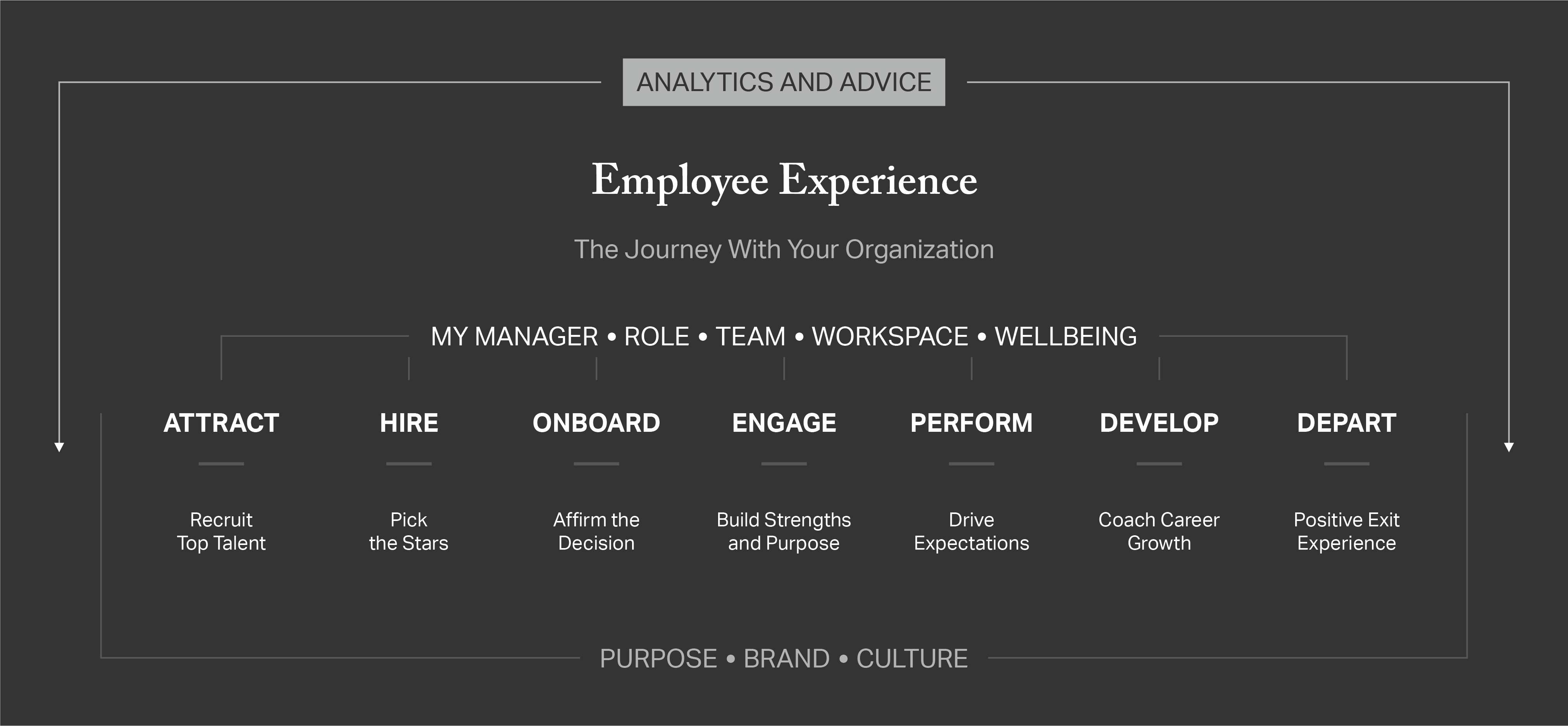Story Highlights
- A stellar employee experience can improve other essential business aspects
- Mapping meaningful moments is key to improving the employee journey
- Manager development prepares managers to deliver exceptional experiences
Every interaction, every moment that employees have with your brand influences whether they'll stay with your organization. From social media posts to hallway conversations, the experiences employees have with your organization shape how they feel about it. In fact, your employee experience starts before people even apply: Every day, potential hires quietly grade your workplace, asking themselves whether it would deliver the moments that matter most to them.
And employees can afford to be choosy in today's tight labor market. People want meaningful work, and they're cherry-picking workplaces that support their career and lifestyle goals. Gallup data show that about half of currently employed workers (48%) say they are actively looking for a new job or watching for openings.
In this climate, smart leaders think of employees more like customers whose "business" they need to earn. And to win employees' interest, you need a competitive employee experience.
The benefits of a great employee experience go beyond talent acquisition -- workplaces that invest in their employee experience can reap dividends in their customer experience, too. Consider your sales team, for example: If they receive the coaching and development they want, they're more willing to go the extra mile for clients.
What Makes an Employee Experience Exceptional?
The employee experience is a journey. It encompasses every interaction employees have with your workplace, from Instagram posts they see before they apply to conversations they have with seasoned colleagues. An exceptional employee experience results when employees have more than just a few great moments -- it's the result of frequent, meaningful interactions over the course of their employment.
The employee life cycle identifies the seven major stages in the employee experience that leaders should focus on in their employee experience strategy. These landmark moments include key milestones -- such as onboarding -- and ongoing aspects of the employee experience, such as performance conversations. At each stage, leaders can implement targeted best practices to improve employees' perceptions of their workplace.

Graphic showing the employee experience: attract, hire, onboard, engage, perform, develop and depart
The Seven Essential Stages of the Employee Life Cycle
-
Attract: Recruit Top Talent
High-talent individuals are particularly interested in working for organizations with a strong purpose and well-defined values -- and live them out authentically. -
Hire: Pick the Stars
An exceptional hiring process is clear and well-aligned with the organization's aspired purpose, brand and culture. To create a fair hiring process, organizations should use objective, scientifically rigorous talent assessments that predict performance. Companies that do realize greater overall performance, including 10% higher productivity, reduced turnover and higher profitability. -
Onboard: Affirm the Decision
Only 12% of employees strongly agree their organization does a great job of onboarding. Effective onboarding goes beyond learning the ropes of the job. Employers should help employees quickly socialize on their team, connect with the organization's purpose and values, and understand how to apply their strengths to achieve excellence. - Build Strengths and Purpose
Employee engagement is about far more than a satisfying work environment. Employees today are looking for a manager who cares about them, keeps them accountable, and focuses on future excellence and career growth opportunities. -
Perform: Drive Expectations
Employees want regular informal feedback and recognition for excellent work. They need to feel that their performance -- reflecting their individual achievement, team collaboration and customer value -- is reviewed in a fair and comprehensive way. -
Develop: Coach Career Growth
Employees expect to see a path forward in your organization -- opportunities to gain new skills, work with new people or enjoy greater autonomy. These professional development opportunities best arise through ongoing coaching conversations. When employees lack development, they will look elsewhere: The No. 1 reason people change jobs today is for "career growth opportunities." -
Depart: Positive Exit Experience
Leaving the organization can be the most emotional and uncertain phase of an employee's journey. When employees have a positive exit experience, they're more likely to become proud brand ambassadors who strengthen your brand's reputation.
An exceptional employee experience results when employees have more than just a few great moments -- it's the result of frequent meaningful interactions over the course of their employment.
How to Optimize Your Employee Life Cycle
Here's how to get started if you want to sculpt your employee experience to drive real, sustainable returns.
Measure the moments that matter.
Employee life cycle "mapping" measures the employee experience to understand the critical moments that drive engagement -- and moments that warrant improvement. An effective mapping strategy includes comprehensive analytics, from primary survey data to external social listening data. This holistic, objective perspective will show leaders:
-
the moments that matter most to employees
-
success strategies and high points
-
blind spots and turnover risk factors
When employers study how employees are experiencing the seven life cycle stages, they may discover drawbacks in certain stages. Perhaps the hiring process is great, but the onboarding program fails to connect new employees with mentors and friends. Or maybe employees are mostly engaged but do not see a path for development.
Align your employee experience with your purpose, brand and culture.
Here's another reason holistic analytics matter: Data help leaders align their organization's unique purpose, brand and culture with their employee experience. When your employee experience reflects your organization's one-of-a-kind values and mission, every interaction employees have with you is authentic, inspires commitment and supports performance.
For instance, if your core values center on customers, how does your onboarding program showcase your emphasis on customer-centricity? And how does your customer factor into employees' performance reviews?
When every aspect of the employee life cycle -- from attraction to development -- is rooted in a distinctive organizational identity, it creates a coherent experience in which every interaction reinforces the whole.
Hire, train and develop great managers.
Your managers deliver your employee experience. Managers are ultimately responsible for engaging employees, coaching for high performance and promoting long-term, individualized development. Their leadership abilities -- or lack of -- will determine the quality of employees' experiences and whether employees' basic needs are met.
Proven manager development will prepare and inspire managers to have effective conversations and continually help employees see their current and future value to the organization.
Don't leave the most important employee-employer interactions to chance. Meaningful, effective hiring and onboarding processes are essential for setting people up for success. And so are manager interactions centered on engagement, performance, development and retention. The best leaders recognize the interconnected nature of these milestones and keep their employer brand promises at every turn.
When your employee experience reflects your organization's one-of-a-kind values and mission, every interaction employees have with you is authentic, inspires commitment and supports performance.
The result is an engaging employee experience that inspires performance. When leaders see employment as a journey, they can strengthen important experiences that affect employees' attachment to their organization.
Do you need help taking the next step in developing your employee experience? Contact Gallup to learn more about how we are helping organizations like yours every day to transform their culture.
Turn the employee experience into an essential asset for your organization.
- Learn more about the employee experience and how to improve it.
- Download our perspective paper on designing your organization's employee experience.





